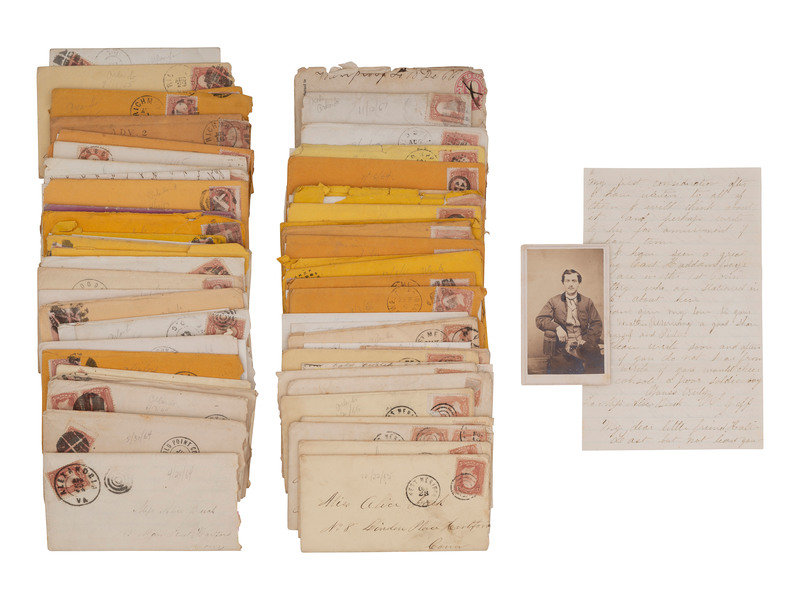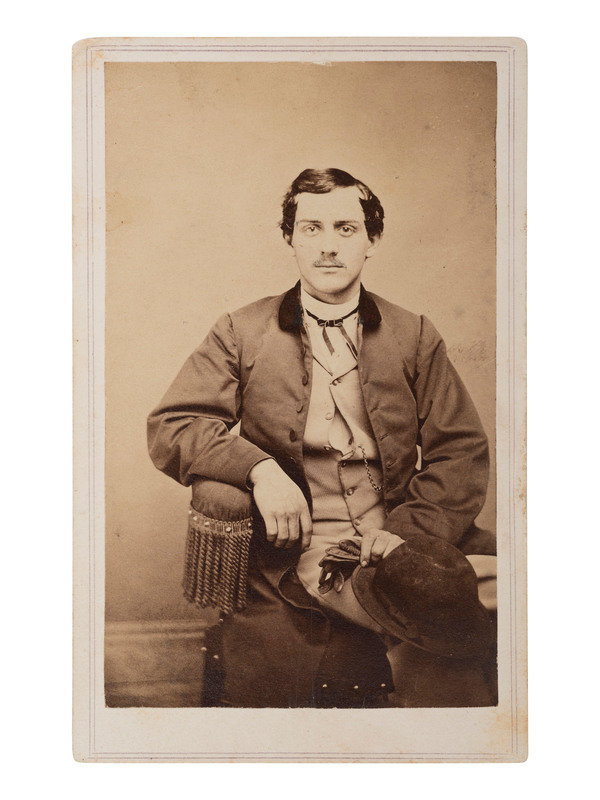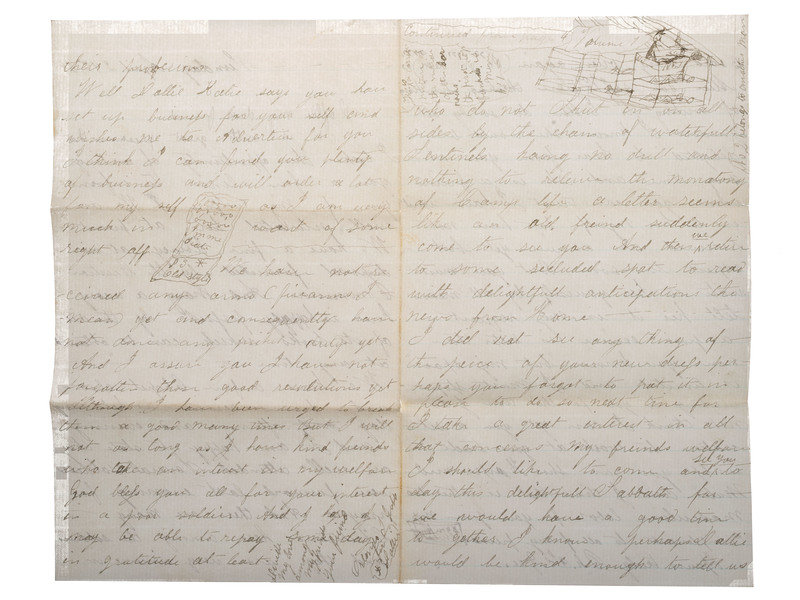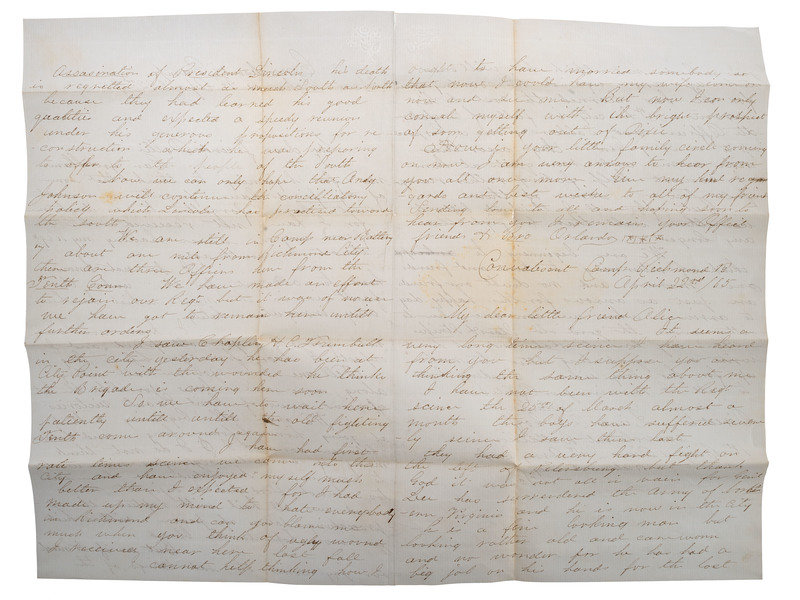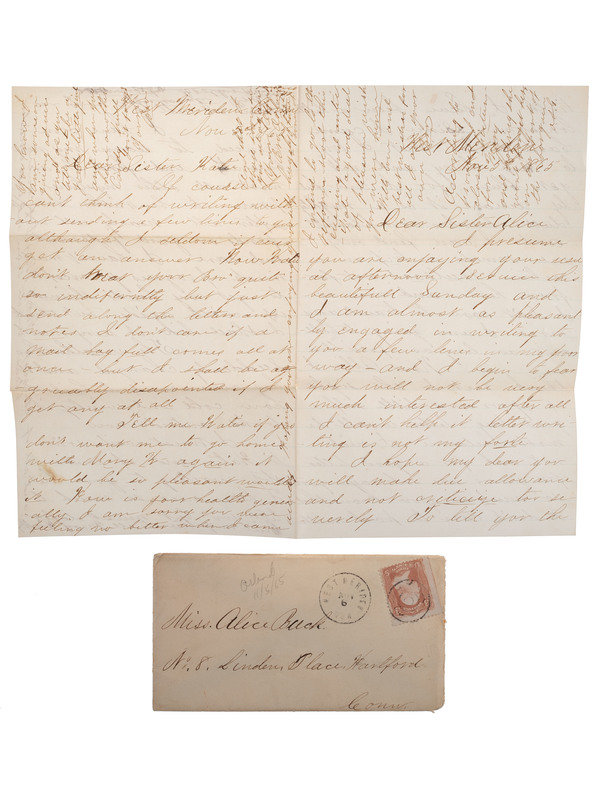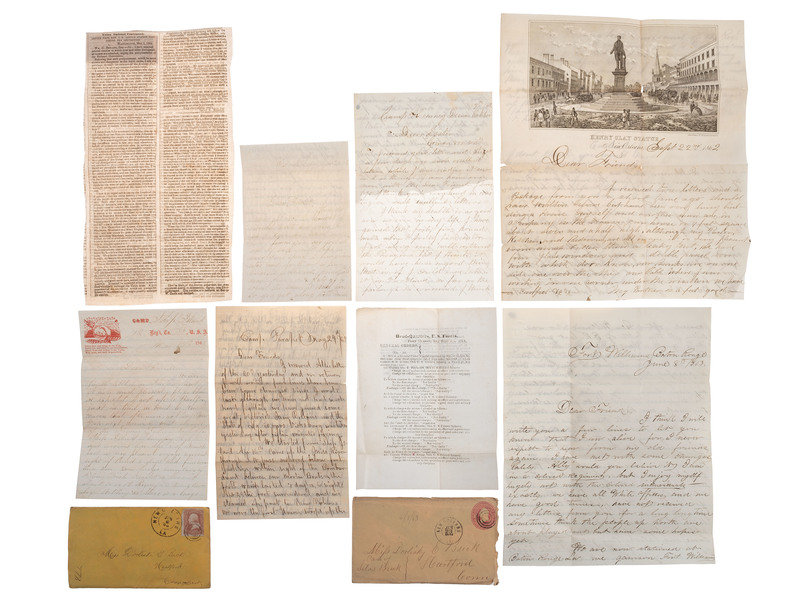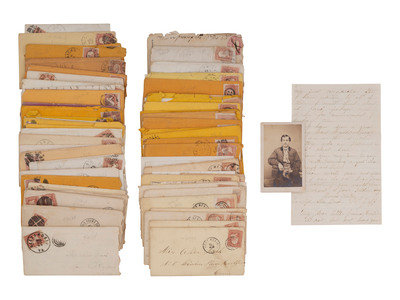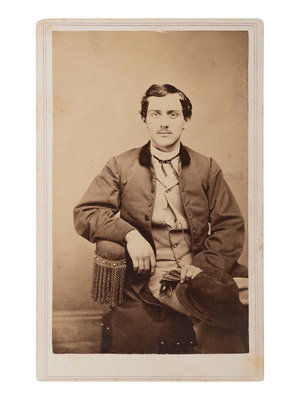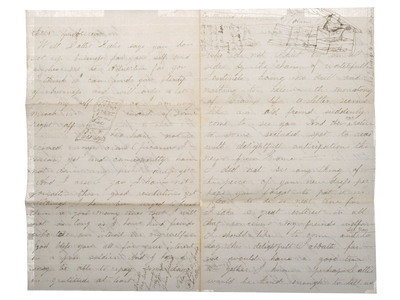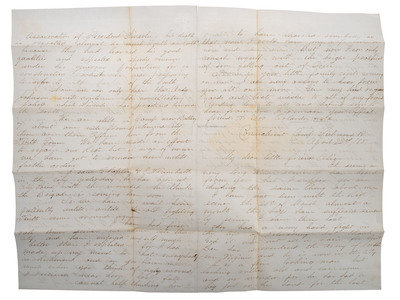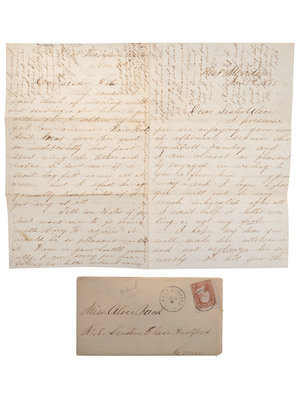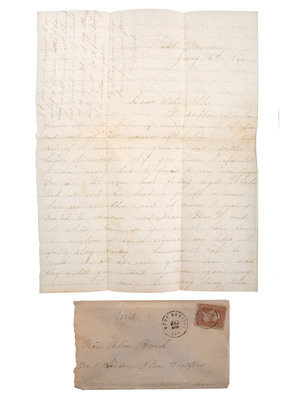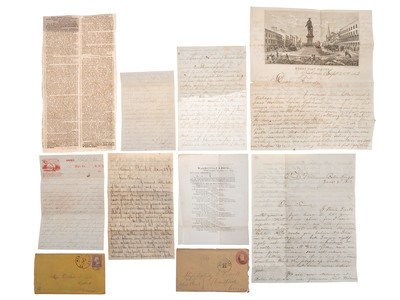Archive of approximately 77 letters spanning April 1864 - April 1868, comprising 47 war-date letters (April '64-August '65) and another 30 post-war letters (October 1865-November 1867, with one letter dated April 1868). Civil War correspondence constitutes in part 35 letters written by Orlando S. Goff while serving in the Connecticut 10th Infantry, 6 letters written by his brother Charles A. Goff while serving with the Connecticut 12th Infantry, another 4 letters written by other Connecticut soldiers. Post-war letters are written by Orlando Goff with the exception of the final 1868 letter which is unsigned. Letters typically 2-4pp, accomplished in legible ink and pencil, most with original covers. All letters are written to one (or more) of the daughters of Silas Buck (1818-1899), a Connecticut carriage maker to whom Orlando Goff was apprenticed before the war. Condition generally good with expected folds and toning, though several letters appear to have missing pages. Provenance: By descent through the family of Alice Buck Penfield (1845-1931) to present owner.
A HISTORICALLY SIGNIFICANT ARCHIVE WHICH INCLUDES PREVIOUSLY UNKNOWN DETAILS OF GOFF'S EARLY PHOTOGRAPHY CAREER.
Though typical of many soldiers' letters from the field, Goff's Civil War letters demonstrate a lesser-known facet of this famed Western photographer - that of a dedicated soldier and patriot. Goff's first letter in the archive, dated 16 April 1864, is addressed to Miss Alice Buck, 148 Main Street Hartford, CT. The second eldest of Silas Buck's daughters, Alice is the addressee on all but two covers and the primary recipient of Goff's correspondence. However, many of Goff's letters include separate sections addressed to two of Alice's sisters, Darliski "Dollie" Buck (1843-1905) and Katherine "Katie" Buck (1847-1930). This first letter authored on a vibrantly colored "Soldier's Farewell!" lettersheet is inscribed on the interior, "O.S. Goff's Compliments / to his freinds [sic] Dollie, Alice & Katie / detachment of 10th Conn Vols / Camp Distribution Va / April 16th 1864." Orlando Goff served almost the entirety of the Civil War. HDS indicates that Goff enlisted on 9/19/1861 as an 18-year old sergeant, mustering into Co. K, Connecticut 10th Infantry, and he re-enlisted on 1/1/1864. By the time of this first letter, he was a seasoned soldier, well accustomed to the hardships of a soldier's life.
In April 1864 the 10th CT was attached to the 2nd Brigade, 1st Division, 10th Army Corps, Dept. of Virginia and North Carolina, then in May was attached to 3rd Brigade, 1st Division, 10th Army Corps. The regiment soon engaged in operations against Petersburg and Richmond. On 29 June 1864, Goff writes about being encamped on the right bank of the James River and "building fortifications for the protection of Transports and the River Navigation." Though not directly engaged in combat operations at that time, he is not out of harm's way. On 3 July 1864 he writes, "I am well as usual and still unhurt by the Rebel bullets that have been flying around so often lately...." Ensuing letters contain typical expressions of a Civil War soldier: missing home, longing for letters, descriptions of camp life, references to deserting Confederates, contraband, skirmishes, and occasional engagements. Writing from "Deep Bottom" on 31 July 1864 Goff characterizes the engagement as "a little brush with the Johnnies" and indicates that his regiment was "a good deal exposed to the enemy's fire." "Near Petersburg" on 18 September he states that it is "rather dull work lying in the trenches 3 days in succession with nothing to do...." Occasionally Goff shared his thoughts on the politics of the day, as on 12 September 1864 when he offered these thoughts on the status of African Americans: "...let all parties take hold to restore the Union in earnest and all will yet be well ... But do not build up a Negro God upon the ruins of our loved Country."
Goff was seriously wounded on 10/13/1864 at the Battle of Darbytown Road. The next letter following his injury is dated 19 October, and was written to Alice Buck on behalf of Goff by "A friend of his." The unidentified soldier indicates that Goff, who was recuperating at the US General Hospital Hampton Virginia, was "wounded in the Battle upon the 13th the Ball entered his right Breast coming out at the side, and passed through the right arm." He then continued, "It did not injure the bone, as he has the use of the arm." A letter written four days later by Orlando's sister "L. Jane Russell" (Lucia Jane Goff Russell) to the Buck sisters relays additional information about Orlando's injury, and demonstrates the strong affection with which she regards her brother. "I do not think the poor boy has an enemy in the world...," she writes.
After an extended recuperation, Goff receives a furlough and travels to New Haven in January 1865. By 27 January 1865 he is heading back to his regiment. Though his regiment participated in the Appomattox Campaign, it seems Goff's injuries prevented him from participating. Writing from "Convalesent [sic] Camp Near Richmond" on 22 April 1865, Goff has missed the surrender of Lee's army at Appomatox Court House where his regiment was present, but writes that soldiers are all beginning to think of going home before long and will not "sigh for more worlds to conquer...we have seen too much bloodshed to enjoy it now and we all hail with rapture the approaching dawn of peace...." Goff writes in the same letter lamenting the loss of Lincoln, of seeing General Lee in Richmond ("[he] is a fine looking man but looking rather old and care worn..."), and of the Confederate soldiers throughout Richmond who "wear their side arms and seem quite at home." He then continues, "I cannot help feeling rather revengeful towards some of them. But after all I think it better to use them well than fight them any longer." The final letter in the archive related to his Civil War service is dated 19 August 1865. Goff mustered out on 8/25/1865 as a 2nd lieutenant.
Goff returned to his native Connecticut after mustering out of the army. His first post-war letter in the archive, written to Alice on 22 October 1865 from West Meriden, Connecticut, demonstrates that Goff was still transitioning into civilian life, and provides the first mention of the man who would soon become his employer. Goff states that he is engaged in manual labor, and is exploring his options: "I have been hard at work all last week but don't like it very much - too much lifting of heavy timbers for me. Don't think I shall stick to this business long it is too hard. If I don't make arrangements with Wheeler soon perhaps I will come to Hartford to work." Two weeks later on 5 November 1865 Goff writes again, seemingly indicating that he has successfully made arrangements with "Wheeler." "I have commenced to learn my business and find it as most all other mysteries prone to be rather simple after all nearly all depends on good judgement and care. I haven't made much progress yet except to get my hands stained up with acids but think I shall like it very much." On 26 November 1865, Goff indicates he is "learning fast as possible and can take a phg[?] that would delight the uninitiated...." Though Goff does not describe it as such, it appears he is learning the process of wet plate photography and has embarked upon an apprenticeship with photographer Frank W. Wheeler (1837-1923) of West Meriden, Connecticut.
Wheeler, the son of a mechanic, was a machinist by trade. According to his obituary, he came to Meriden in the late 1850s to work for the firearms manufacturer Parker, Snow, Brooks & Co., then "becoming interested in the art of portrait photography...became one of the pioneers in that field." A 1922 history of Meriden indicates that Wheeler worked for Meriden manufacturers "who used to photo-graph their new designs in place of having their sales-men carry samples." The 1866 Connecticut Business Directory (page 136) identifies Frank Wheeler as a photographer in Meriden, indicating that he was well-established in the field by the time that Goff embarked on his photographic apprenticeship. Newspaper advertisements from the Meriden Daily Republican herald "Mr. Frank Wheeler's photographic gallery" (27 September 1869), noting that his "long experience in photographing, together with his merit as an artist, has won for him an enviable reputation among photographers..." (28 June 1870). Backmarks attributed to Wheeler include "Frank Wheeler" and "F. Wheeler" of West Meriden, as well as "Wheeler" of Cold Spring, New York, and "F.W. Wheeler" of Richford, Vermont.
On 28 January 1866 Goff describes another new process he is learning: "we have been busy lately on some porcelain pictures and have had very good success. It is quite an improvement as I presume you are aware it is a new thing down here in rustic Meriden...." Then on March 4 he writes, "I have been very busy and like my new business first rate." Later that month Goff shares that Wheeler has opened a new photography studio: "I feel a little blue sometimes but have too much employment to have it last long. Wheeler has gone now to Cold Spring, NY and has a Photo Room there in operation about the middle of next month I am to change off with him and shall be father away from Home more than ever." Goff also notes in May 1866 that Wheeler "has been to Deep River and made some large views of the Ships Yard and has gone back to New York again, he has sent for me to come out [to Cold Spring] then friday [sic] night so you see I am off ... I think sometimes that I am doomed to be a wanderer on the face of the earth but for what particular sin I can't imagine...."
The remaining letters feature in large part discussions of life, family, and to some extent discussion of Wheeler. Both Goff and Wheeler are back and forth to Cold Spring, with Goff operating the photography studio in Meriden when Wheeler is in Cold Spring and vice versa. As 1867 progresses, Goff's letters are increasingly sent from Cold Spring with Goff describing life there, his bouts of loneliness when work is slow, and his leisure pursuits and activities including being a part of the Sons of Temperance organization. By the summer of 1867 as more people venture "up the River" to Cold Spring Goff finds himself at last enjoying his time there and feeling at home. The final letter in the archive dated 10 November 1867 includes sections written by both Katie Buck and Goff to the other Buck sisters. Goff is in Hartford visiting and expresses his apologies for not writing more often: "Did you begin to think I had been lost in the wilderness and begin to congratulate yourselves on being rid of an unprofitable investment? I am sorry to disappoint you. I am almost invincible - have more lives than the celebrated cat."
Goff's life would indeed seem to encompass multiple iterations, as he soon ventured westward and embarked upon a legendary career. The letters offered here demonstrate Goff's immediate and unabashed enthusiasm for the art of photography, and paint a fascinating portrait of a young man who continually longed for home yet forged a life on the American frontier. More importantly, the post-war correspondence identifies for the first time the specific timeframe in which Goff began to learn the trade of photography - a date roughly two years earlier than previously assumed based on the limited documentary evidence available - and reveals from whom he learned the art of photography. Given that institutional collections are nearly void of personal papers and business records related to Goff and his work, this archive unquestionably represents a significant historical collection.
[With:] CDV, seated portrait view of Orlando S. Goff, ca 1866-1867. 2 3/8 x 4 in. CDV on cardstock mount (wear to edges and corners, light spotting) with backmark "Wheeler / Photographer / Cold Spring, N.Y." Inscribed "I send you this but do not like it very well myself. O.S. Goff." Image appears to be previously unrecorded, and may be the earliest known image of Goff. -- Tintype of unidentified soldier, possibly Charles A. Goff (image dark, surface wear around edges, revenue stamps on verso), ca 1864.
